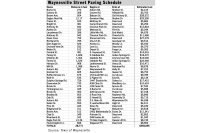Arrrggghh – a wintry mix
 Limeade, tequila and cointreau is not a wintry mix — that is a margarita; something you may resort to when a wintry mix turns your driveway into a sheet of ice.
Limeade, tequila and cointreau is not a wintry mix — that is a margarita; something you may resort to when a wintry mix turns your driveway into a sheet of ice.
The ingredients for a wintry mix are a combination of two or more of these types of frozen/freezing precipitation, snow, ice pellets/sleet, freezing rain and/or graupel (pronounced grapple.) Basic precipitation mechanics are involved.
Warm moist air rises — this is called atmospheric lift and it is the same process in July as it is in February. The warm air rises as water vapor or clouds. When it gets cool enough the water vapor condenses back into a liquid. Just like dew on a blade of grass, the water vapor has to have something to condense upon. No problem, the atmosphere, like the air behind your vacuum cleaner’s exhaust, is full of atmospheric debris. Most of this debris is in the form of microscopic dust, dirt and/or salt and provides the moisture something to latch onto. Depending on the temperature in the cloud, this condensation is either in liquid or frozen form. If the temperature in the cloud is above freezing and the temperature between the earth and the cloud is above freezing — rain.
Often in July, in the northern hemisphere, those thunderheads reach so high that the precipitation starts out frozen. In most cases the air between terra firma and the cloud is warm enough that the ice melts and falls to Earth as rain. But sometimes those ice droplets have been so busy colliding and sucking up water vapor and growing that they are too big to thaw before reaching ground and we have a hailstorm.
In the winter it gets a bit more d(icey.) Arctic clippers fly down from the north; moisture-laden warm Gulf air blows in from the South, high pressure systems bump into low pressure systems and we often wind up with layers of warmer/colder air in the atmosphere. It’s easy to see with all the variables — how cold is the cold air, how warm is the warm air, how thick is the warm layer, how thin is the cold layer — why the six o’clock weather person looks like a deer in the headlights and is left to meekly proclaim a “wintry mix.”
But there are some general scenarios. Freezing rain may start out, initially as ice, but it melts as it falls through warmer air only to encounter cold air again near the Earth’s surface. This cold layer super-cools the droplets and while they still fall as liquid they immediately freeze upon contact with any object, like, say, your driveway. If these droplets refreeze again before they land on your driveway they are known as sleet.
Related Items
There is also a cool snow, freezing rain hybrid called graupel.
Graupel is formed when freezing rain settles on snow crystals, creating a snow crystal with rime ice. Graupel is most common at high elevations, like the Rockies or the Alps, but I’ve seen it here. You probably have too — it looks like tiny styrofoam balls of snow.
As the illustration shows, a cloudy winter day can result in any combination of rain, snow, sleet, graupel and/or freezing rain. It’s the reason those weather persons’ eyes look like they’re covered in freezing rain when they announce a “wintry mix.” And the reason why, for some of us the “bread and milk” run to the grocery includes limeade, tequila and cointreau.
(Don Hendershot is a writer and naturalist. He can be reached a This email address is being protected from spambots. You need JavaScript enabled to view it..)









